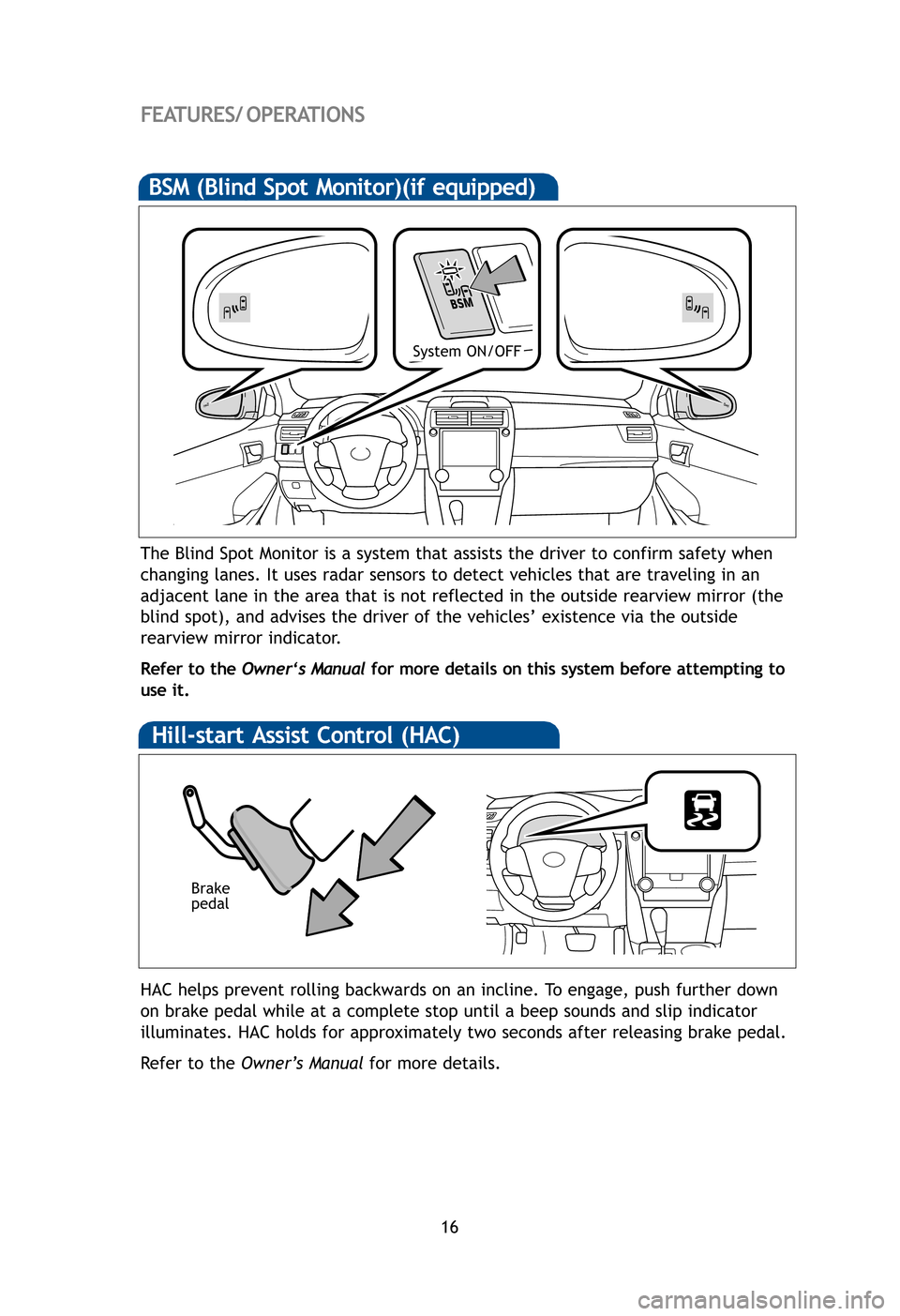sensor TOYOTA CAMRY HYBRID 2012 XV50 / 9.G Quick Reference Guide
[x] Cancel search | Manufacturer: TOYOTA, Model Year: 2012, Model line: CAMRY HYBRID, Model: TOYOTA CAMRY HYBRID 2012 XV50 / 9.GPages: 31, PDF Size: 1.71 MB
Page 18 of 31

16
FEATURES/ OPERATIONS
The Blind Spot Monitor is a system that assists the driver to confirm sa\
fety when
changing lanes. It uses radar sensors to detect vehicles that are travel\
ing in an
adjacent lane in the area that is not reflected in the outside rearview \
mirror (the
blind spot), and advises the driver of the vehicles’ existence via t\
he outside
rearview mirror indicator.
Refer to the Owner‘s Manualfor more details on this system before attempting to
use it.
Mo
Slid
Mu
Pu
(1
(2
(3
(4
(5
(6
Push
posit
BSM (Blind Spot Monitor)(if equipped)
System ON/OFF
Hill-start Assist Control (HAC)
HAC helps prevent rolling backwards on an incline. To engage, push further down
on brake pedal while at a complete stop until a beep sounds and slip ind\
icator
illuminates. HAC holds for approximately two seconds after releasing bra\
ke pedal.
Refer to the Owner’s Manual for more details.
Brake
pedal
resize-camry.r1_Layout 1 10/13/11 10:21 PM Page 16
Page 28 of 31

26
Star Safety SystemTM
VSC helps prevent loss of traction during cornering by reducing engine powe\
r and
applying brake force to selected wheels.
Toyota’s VSC monitors steering angle and the direction your vehicle is traveling\
.
When it senses that the front or rear wheels begin to lose traction, VSC red\
uces
engine power and applies braking to selected wheels. This helps restore traction
and vehicle control.
Vehicle Stability Control (VSC)
Anti-Lock Brake System (ABS)
Brake Assist (BA)
ABS helps prevent brakes from locking up by "pulsing" brake pressure to eac\
h
wheel. This limits brake lockup and provides the maximum brake effectiveness for
the current road conditions.
Toyota's ABS sensors detect which wheels are locking up and limits wheel lockup by
"pulsing" each wheel's brakes independently. Pulsing releases brake pressure
repeatedly for fractions of a second. This helps the tires attain the maximum
traction that the current road conditions will allow, helping you stay in control.
Brake Assist is designed to detect sudden or “panic” braking, and then add bra\
king
pressure to decrease the vehicle’s stopping distance. When there’s only a split
second to react, Brake Assist can add additional brake pressure more quickly than
just the driver alone can. VSC helps prevent loss of traction during cornering by reducing engine powe\
r, and
Traction Control helps maintain traction on loose gravel and wet, icy, or uneven
surfaces by applying brake force to the spinning wheel(s).
Toyota’s TRAC sensors are activated when one of the drive wheels starts to slip.
TRAC limits engine output and applies the brakes to the spinning wheel. This
transfers power to the wheels that still have traction to help you drive safely.
Traction Control (TRAC)
Electronic Brake Force Distribution (EBD)
Toyota’s ABS technology has Electronic Brake-force Distribution (EBD) to help
maintain stability and balance when braking. Abrupt stops cause the vehicle to tilt
forward, reducing the braking power of the rear wheels. EBD responds to sudden
stops by redistributing brake force to maximize the braking effectiveness of \
all
four wheels.
SAFETY AND EMERGENCYFEATURES
All new Toyota vehicles come standard with the Star Safety SystemTM, which
combines Vehicle Stability Control (VSC), Traction Control (TRAC), Anti-lock Braking
System (ABS), Electronic Brake-force Distribution (EBD), Brake Assist (BA) and Smart
Stop Technology (SST).
Ther
has m
For s
• O
•
Us pl
•In
Flo
Smar
and
SST
e
firml
SSTd
allow
back
Sma
resize-camry.qxd 10/12/11 4:59 AM Page 26